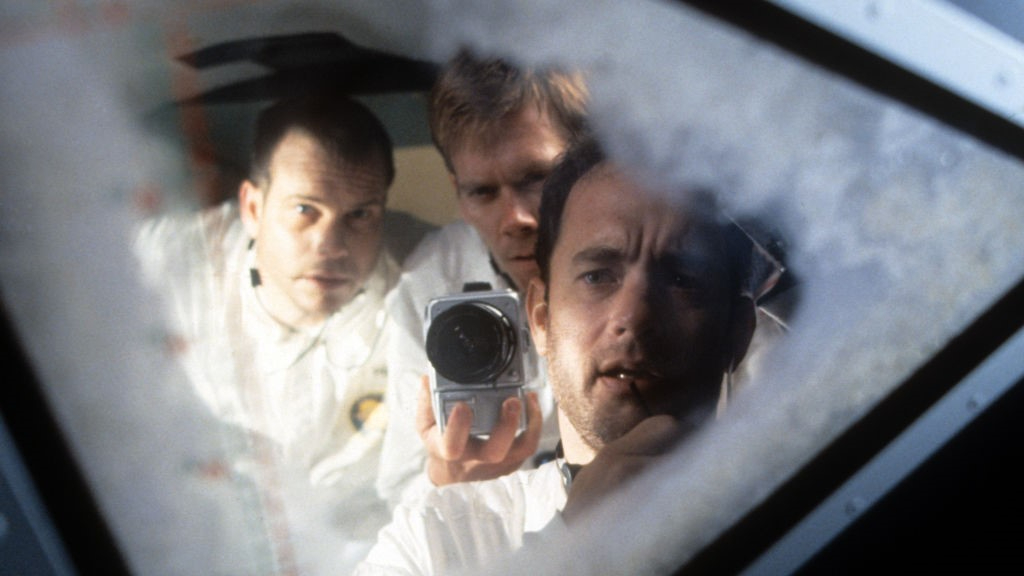
Houston, we have a new reason to celebrate 1995's "Apollo 13" movie.
The iconic space film — based on the near-disaster of NASA's 1970 Apollo 13 human moon mission — was named part of the Library of Congress' National Film Registry on Wednesday (Dec. 13). Each year, the registry selects 25 films for inclusion due to their "cultural, historic or aesthetic importance."
Film director Ron Howard told the Library of Congress about how he'd asked Apollo 15 astronaut David Scott to serve as technical advisor on the film, a role that Scott indeed accepted. The film was also based on a memoir co-authored by Apollo 13 commander Jim Lovell, and space journalist Jeffrey Kluger. Howard said he knew individuals in the space program would be watching "Apollo 13" closely for accuracy. "You have the chance to really get it right and let people know what the Apollo era was all about," Howard said of Scott's advice. "We took that very seriously."
By coincidence, "Apollo 13" earns its new accolade just as NASA continues planning for modern human landings on the moon with the Artemis program — aptly named for the Greek goddess of the moon and twin sister to Apollo, who is actually the Greek god of the sun. "Apollo 13" star Tom Hanks recently met with the Artemis 2 round-the-moon crew ahead of their expected launch in 2024 or so.
Related: Tom Hanks would clean toilets for a chance to go to space: report
The "Apollo 13" movie astronaut crew included Hanks (as Lovell), Kevin Bacon (command module pilot Jack Swigert) and Bill Paxton (lunar module Fred Haise). As the film showed, Apollo 13 encountered a near-fatal explosion on the way to the moon on April 13, 1970. The incident crippled the command module spacecraft, named "Odyssey." Luckily, the attached lunar module, "Aquarius," was undamaged. Aquarius served as the crew's lifeboat for three days until the team safely splashed down in the Pacific Ocean.
Howard said the actors were devoted to getting small details right; for example, in a unique bit of filming history, the actors and crew voluntarily spent dozens of hours aboard the KC-135 "vomit comet" parabolic aircraft to induce real-life weightlessness on Hanks, Bacon and Paxton. "I was very proud of the outcome," Howard said of the film. "The experience remains an absolute highlight. It was one of those experiences that none of us involved in will ever forget."
The movie also included some of the real-life human drama surrounding the mission. Gary Sinise (as astronaut Ken Mattingly) was Apollo 13's prime command module pilot, who was grounded days before flight after he was accidentally exposed to the German measles.
Ed Harris (as flight director Gene Kranz) led the Mission Control "tiger team" that adapted procedures on the fly to help the astronauts get home safely. Meanwhile, Kathleen Quinlan (Marilyn Lovell, wife of Jim Lovell) showcased the frustration the families felt with the amount of information they had from NASA about the emergency; that was reflected in Lovell's memoir, too.
Related: Apollo 13 at 50: How NASA turned near-disaster at the moon into a 'successful failure' in space
In real life, NASA implemented numerous "lessons learned" after the Apollo 13 accident to introduce more redundancy in spacecraft oxygen and electrical systems mirroring those affected by the explosion, among other matters. Today, the agency also has designated astronauts who serve as liaisons to families whose loved ones are in space; this allows the families to get timely information and support from a NASA astronaut in case of troubles in orbit, or if they need extra help at home.
"Preservation" of a film means the LOC will commit to getting a well-preserved copy of "Apollo 13" and storing it in a special vault at the National Audio-Visual Conservation Center in Virginia for future generations. That said, the library already has 1.1 million films available there for copyright registration purposes, Mental Floss reported in 2018. Most Hollywood productions would therefore only need a quick verification check to make sure the copy on file is still in good condition.
The participating astronauts have commented on the film's veracity over the decades, with the exception of Swigert, who died of cancer in 1982 at age 51, more than a decade before the film's release or the book's production.
Haise, speaking with Space.com in June 2022, said his only complaint about the movie was it didn't show enough of the thousands of people working to get his crew home safely. "That was one shortcoming in the movie. It didn't have the real cast," he said.
Related: Apollo 13 astronauts Jim Lovell and Fred Haise on their moon mission 50 years later

Lovell, appearing on air with comedian Conan O'Brien in July 1995 shortly after the release of "Apollo 13," praised Howard and the team for the film. (Lovell made a cameo in "Apollo 13" as the recovery ship captain at the end, shaking the hand of Hanks on deck.)
"When I first got together with Ron, and he wanted to make a movie out of the book, I said, 'Ron, if you just take the actual story, don't hype it. Just do what was there,'" Lovell recalled." 'There's so much adventure, so much suspense, that your job will be what to throw out to keep the movie at a certain length.' And that's what happened."
Lovell, however, hinted that the shouting and fighting the crew famously engaged in on film — on the ground and in space — were exaggerated. "We were test pilots," he said of the prime and backup crews, who represented all the major U.S. military branches. "We had the training in the past. We were in some crises before. You know, if you panic, where would you go?"
Mattingly told NASA's Johnson Space Center oral history project in 2001 that "Apollo 13" was "a pretty good movie." But he also said the film suggested "we invented a lot of stuff," instead of their actual approach of adapting procedures for the emergency. "Thanks to the kind of simulation training program we had — maybe the things weren't exactly the same, or in exactly the same order — everything we ended up doing had been done somewhere."







